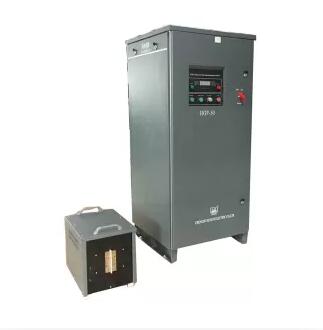Login

Login

Oct. 14, 2025
In our country, the use of high-frequency induction heating machine welded steel pipes has been applied in the 50s of the 20th century, and induction heating welded steel pipes have been very commonly used so far. However, the use of high-frequency induction heating machine to weld aluminum pipes was still in the experimental stage at that time, and the use of induction heating to weld aluminum tubes abroad began in the 60s, and by the 70s, the number of applications of high-frequency heating welded aluminum tubes in the United States has reached about 50% of the total aluminum pipes. Welding aluminum tubes with high-frequency induction heating machines has fast welding speed, narrow weld heat affected area, good weld quality, and high production efficiency, so in the industry of manufacturing aluminum tubes, it will be a developing process. In 2006, Zhifa Technology made special high-frequency equipment for welding aluminum tubes for a branch of an automobile manufacturing plant in Shenzhen, Guangdong, and achieved success. When welding Φ9×0.3mm aluminum pipes, the welding speed reaches 120m/min, and the quality is all qualified.
The technical difficulties of high-frequency induction heating machine for aluminum tube welding process are as follows:
(1) Aluminum has a low melting point, high thermal conductivity, large heat capacity, and large thermal expansion coefficient.
(2) Aluminum and oxygen have a great affinity, and their oxides will cause inclusions in the weld.
(3) Aluminum can absorb a large amount of hydrogen in the liquid state, so aluminum welding is easy to form pores.
(4) When the heating temperature of aluminum and its alloys reaches the melting point, the process of changing from solid to liquid state proceeds quickly and there is no color change, so there are certain difficulties in welding.

In view of the technical difficulty of the aluminum tube welding process, the following requirements are required for high-frequency induction heating machines:
(1) Use a higher frequency to make the heat-affected zone of the weld narrow and the current of the inner wall of the pipe to be reduced.
(2) The power density of the weld is required, and the faster the welding speed, the better the weld quality.
(3) The DC voltage of the electron tube anode is required to be stable and smooth, and its pulsation coefficient is required to reach about 1%. Several measures used by high-frequency induction heating machine when welding aluminum pipes:
(1) Use a higher frequency, at least 100KHz or more, so that the highest frequency reaches 700~800KHz.
(2) The output power is slightly higher, so that the welding speed of aluminum tubes is higher.
(4) Reasonable oscillation circuit should be convenient for load adjustment.
Application prospects of high-frequency induction heating machine for welding aluminum pipes:
Aluminum products or utensils have the characteristics of large reserves, high specific strength, light weight, corrosion resistance, etc., so after welding aluminum pipes with large quantities and low costs, they are widely used in agricultural sprinkler irrigation systems, chemical industry, light textiles, light buildings and furniture to replace steel pipes, because the cost of steel pipes is higher than that of aluminum pipes. At present, domestic welded aluminum pipes mostly use argon arc welding, the speed is very low, and the use of high-frequency induction heating machine welding is used to replace it, which can reach a very high speed. The induction heating equipment manufactured by Zhifa Technology can reach a welding speed of more than 120m/min for small-diameter thin-walled pipes. In addition, high-frequency welding can also be used to weld stainless steel pipes, copper pipes, brass pipes, etc., as well as non-conductive magnetic metal pipes. This new technology is expected to attract the attention of professional pipe manufacturers.
31 0 0
Join Us

Comments
All Comments ( 0 )